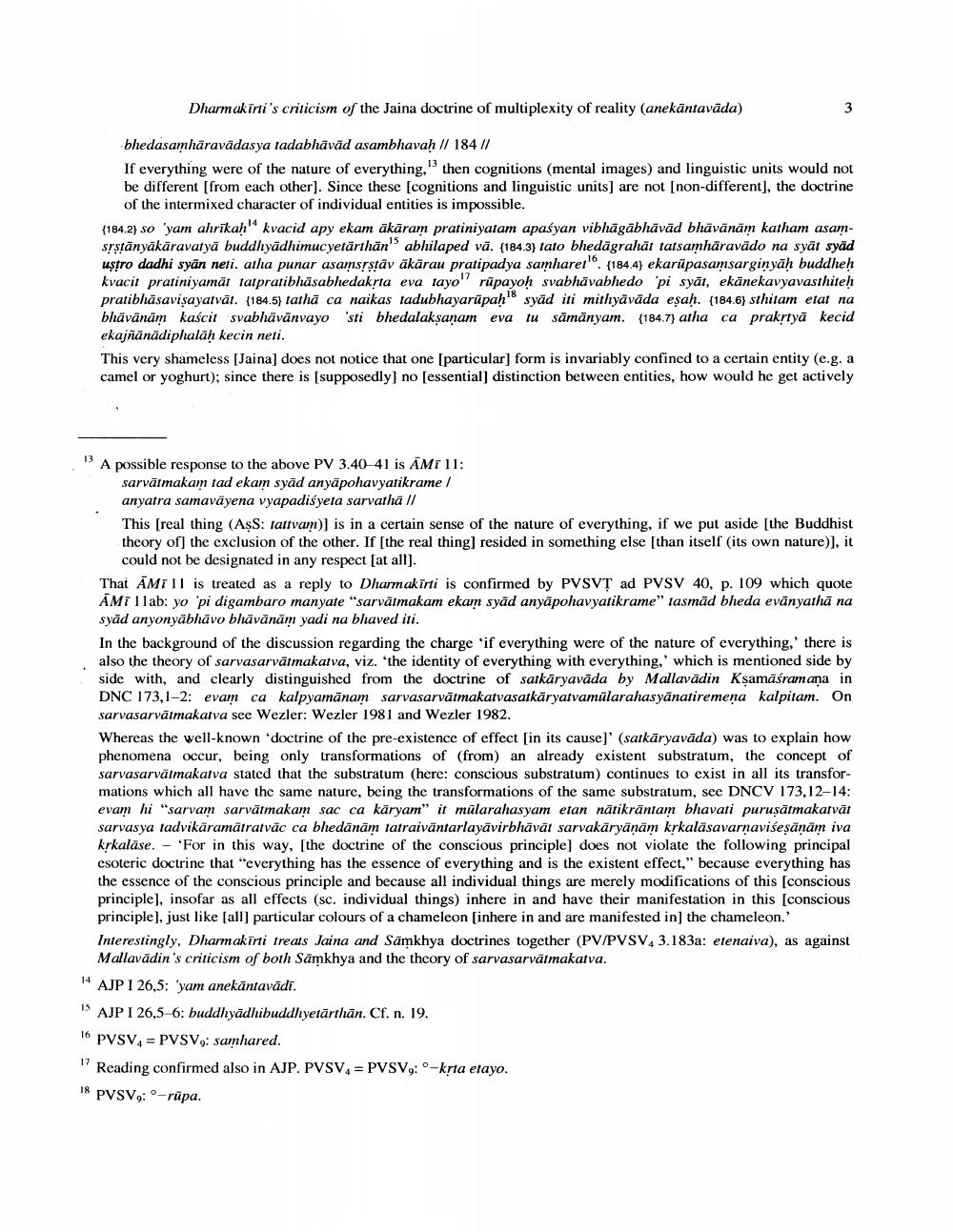Book Title: Dharmakirtis Criticism Of Jaina Doctrine Of Multiplexity Of Reality Anekantavada Author(s): Piotr Balcerowicz Publisher: Piotr Balcerowicz View full book textPage 3
________________ Dharmakirti's criticism of the Jaina doctrine of multiplexity of reality (anekāntavāda) bhedasamhäravādasya tadabhāvād asambhavah // 184 // If everything were of the nature of everything, then cognitions (mental images) and linguistic units would not be different [from each other]. Since these [cognitions and linguistic units] are not [non-different], the doctrine of the intermixed character of individual entities is impossible. (184.2) so 'yam alrikah' kvacid apy ekam ākāram pratiniyatam apaśyan vibhāgābhāvād bhāvānām katham asamsrstānyākāravatyā buddhyādhimucyetārthān" abhilaped vā. {184.3) tato bhedāgrahāt tatsamhāravādo na syāt syād ustro dadhi syān neti. atha punar asamsrstāv ākārau pratipadya samharet! (184.4) ekarūpasamsarginyāh buddheh kvacit pratiniyamăt tatpratibhasabhedakrta eva tayo" rūpayoh svabhāvabhedo 'pi syāt, ekānekavyavasthiteh pratibhāsavisayatvāt. (184.5) tathā ca naikas tadubhayarūpah syād iti mithyāvāda eşah. (184.6) sthitam etat na bhāvānām kaścit svabhävänvayo 'sti bhedalaksanam eva tu sämānyam. (184.7) athaca prakrtyā kecid ekajñānādiphalāh kecin neli. This very shameless [Jaina] does not notice that one (particular] form is invariably confined to a certain entity (e.g. a camel or yoghurt); since there is supposedly) no (essential] distinction between entities, how would he get actively 13 A possible response to the above PV 3.40 41 is AMi 11: sarvātmakam tad ekam syād anyāpohavyatikrame / anyatra samavāyena vyapadiśyeta sarvatha // This (real thing (AşS: tattvam)] is in a certain sense of the nature of everything, if we put aside (the Buddhist theory of the exclusion of the other. If [the real thing) resided in something else [than itself (its own nature)], it could not be designated in any respect (at all). That AMill is treated as a reply to Dharmakirti is confirmed by PVSVȚ ad PVSV 40, p. 109 which quote ĀMillab: yo 'pi digambaro manyate "sarvatmakam ekam syâd anyāpohavyatikrame" tasmād bheda evānyathā na syäd anyonyābhāvo bhāvānām yadi na bhaved iti. In the background of the discussion regarding the charge 'if everything were of the nature of everything, there is also the theory of sarvasarvātmakatva, viz. 'the identity of everything with everything,' which is mentioned side by side with, and clearly distinguished from the doctrine of satkāryavāda by Mallavādin Ksamāśramana in DNC 173,1-2: evam ca kalpyamānam sarvasarvātmakatvasatkāryatvamülarahasyänatiremena kalpitam. On sarvasarvatmakatva see Wezler: Wezler 1981 and Wezler 1982. Whereas the well-known doctrine of the pre-existence of effect [in its cause)' (satkāryavāda) was to explain how phenomena occur, being only transformations of (from) an already existent substratum, the concept of sarvasarvālmakatva stated that the substratum (here: conscious substratum) continues to exist in all its transformations which all have the same nature, being the transformations of the same substratum, see DNCV 173,12–14: evam hi "sarvam sarvātmakam sac ca kāryam" it mülarahasyam etan nātikrāntam bhavati purusātmakatvāt sarvasya tadvikāramátratvāc ca bhedānām tatraivāntarlayāvirbhāvāt sarvakāryānām krkalāsavarnavišeşānām iva krkalāse. - 'For in this way, [the doctrine of the conscious principle] does not violate the following principal esoteric doctrine that everything has the essence of everything and is the existent effect," because everything has the essence of the conscious principle and because all individual things are merely modifications of this [conscious principle], insofar as all effects (sc. individual things) inhere in and have their manifestation in this [conscious principle), just like (all) particular colours of a chameleon [inhere in and are manifested in the chameleon.' Interestingly, Dharmakirti treats Jaina and Samkhya doctrines together (PV/PVSV43.183a: etenaiva), as against Mallavādin's criticism of both Samkhya and the theory of sarvasarvatmakatva. 14 AJP I 26,5: 'yam anekāntavādi. AJP I 26,5 6: buddhyādhibuddhyetārthān. Cf. n. 19. 16 PVSV. = PVSV, samhared. " Reading confirmed also in AJP. PVSV4 = PVSV,: O-krta etayo. 18 PVSV, -rüpa.Page Navigation
1 2 3 4 5 6 7 8 9 10 11 12 13 14 15 16 17 18 19 20 21 22 23 24 25 26 27 28 29 30
